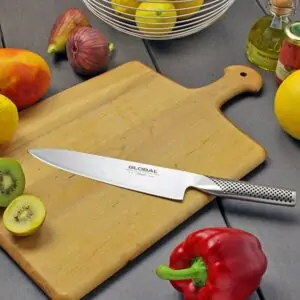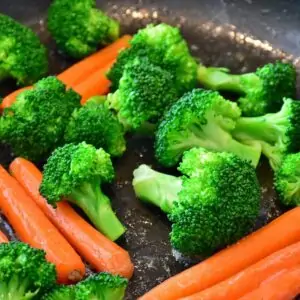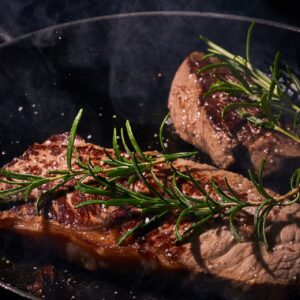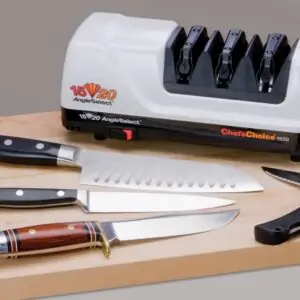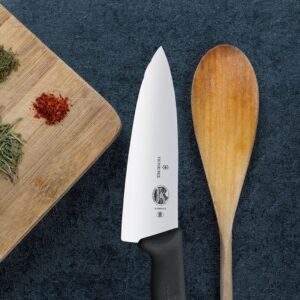If you want to improve your cooking skills, the best place to start is with the basics. And nothing is more basic – or more important – than improving your knife skills. Improving those knife skills starts with using a good quality chef’s knife. Every meal I make begins with pulling my chef’s knife off the magnetic holder next to my cutting board and breaking down whatever I’m cooking. That often means dicing aromatics, such as onions, celery, carrots, or garlic, before I sauté them for a soup, curry, or tomato sauce. But it could equally as often be breaking down a whole chicken into parts for grilling, slicing open a sausage casing to cook some meat for a Bolognese, or prepping all my veggies for a quick clean-out-the fridge stir fry.
The chef’s knife is the undisputed workhorse of the kitchen, my most valuable tool, and my cast iron skillet, woodblock cutting board, and Dutch oven. But with the plethora of knives out there, where does the discerning home cook begin? How does one decide what kind of a chef’s knife to invest in? And do you need to spend hundreds of quid to get the best knife?
In this primer on Chef’s Knives, I’ll try to answer these questions and more. So let’s get started!
JUMP TO:
How To Choose A Chef’s Knife
The first step is to think about what and how often you like to cook at home. I assume you’re doing most of your cooking from scratch, or you wouldn’t need a good chef’s knife. Ask yourself:
“What do I like to cook at home?”
“How often do I (realistically) cook at home?
Answering these questions can start you thinking about what kind of knife will work best for you. If you’re simply an occasional home cook, then an inexpensive chef’s knife from a big box store is all you need. However, if you find yourself regularly making meals at home for you and your family, trying new recipes every weekend, or working to improve your knife skills, the next step in your home cooking journey is a good-quality chef’s knife. A good chef’s knife will increase the ease of dicing, slicing and chopping, thereby increasing the enjoyment of home cooking.

What NOT To Buy
Most of us don’t need that starter set of 12 knives and the accompanying wooden block that houses these knives. I’ve never owned one, and I don’t think they’re necessary. The most used knives in my kitchen are the chef’s knife, a paring knife, and a serrated bread knife (these are my essential “go-to” knives). After that, I have a few repeats because there are multiple people in my house, and sometimes we cook together. Having 2 or 3 chef’s knives can come in handy in that situation.
With that said, I would encourage you to skip the knife set and instead start with these three essential knives: 1) chef’s knife, 2) paring knife, & 3) bread (serrated) knife. Skip anything that is single-use, at least at first, until you get a better feel for what you enjoy cooking at home. For instance, I love my boning knife, but I only have one because it was a Father’s Day gift. I use it once every two months to debone meats or carve a roast chicken. It’s super-sharp and not necessary for most home cooks. However, I enjoy breaking down larger cuts of meat with it, so it’s an excellent knife for me in my home kitchen. Don’t eat meat? Then you can easily skip a boning knife. Simple as that.

What Kind Of Knife Should I Get?
Now that we’ve determined what you should NOT get, here’s where things get fun. If the chef’s knife is the workhorse of your kitchen, then you need a good one. Fortunately, breaking your savings account isn’t necessary to get a high-quality chef’s knife. Here’s what to look for in your initial purchase.
1. German vs Japanese?
When shopping for a knife, you’re likely to come across the two main knife categories – German and Japanese knives. While they are not that different, there are a few key differences worth pointing out.
The first thing to note is that German knives tend to be heavy and thicker with a curved edge. This makes them more versatile and ideal for robustness when cutting. Thanks to its wide blade, a German knife can serve you for a lifetime. The only weakness is that it requires regular sharpening.
On the other hand, Japanese knives are lightweight and have a relatively thinner blade with a straight edge. As a result, they are best suited for delicate tasks that require high precision and less pressure. Moreover, unlike German knives, Japanese knives are easy to sharpen and retain their sharpness for longer. The only downside is that they are more vulnerable to cracking and chipping.
2. Size
Look for a chef’s knife approximately 8-10 inches (210-240mm) in length. This will be a great size to start with for most home cooks. Anything smaller will be challenging to use, same with anything larger.
3. Feel
Hold It In Your Hand. Please don’t buy a knife before picking it up and seeing how it feels in your hand. Tbladeife should feel comfortable and easy to use. If not, skip it, and look for something else.
4. Length
Regarding the knife’s length, you have to consider both the blade’s length and the handle. A shorter knife can get your work done efficiently for regular day-to-day kitchen tasks. A shorter blade and handle give you maximum strength and control when cutting through food, thus reducing the risk of the knife slipping from your hands.
On the other hand, when dealing with challenging tasks that need high pressure, such as cutting large meat pieces, a longer and thicker knife is ideal.
5. Control
The right knife should offer good balance and control even when performing challenging tasks. The knife’s weight should be balanced between the blade and the handle. If the blade is heavier than the handle, it will be uncomfortable and unsafe to use. Similarly, if the handle is heavier than the blade, it may not cut efficiently.
A heavier knife is recommended for harder ingredients, such as pumpkin. In addition, some knives are fitted with finger guards to prevent fingers from slipping to the edge.
6. Stainless Steel: The Way To Go
For the home cook buying her first chef’s knife, go for stainless steel. It’s easy to clean, won’t rust, anis d easy to care for. Stainless steel will be your friend when it comes to your first chef’s knife.
7. Holding An Edge
Holding An Edge: A good chef’s knife will hold its edge (that’s a fancy way to say “it will stay sharp”) for some time between sharpening. An inexpensive knife sharpener should be your next purchase AFTER your first chef’s knife.
What Else?
Everything else is just filler. A good quality chef’s knife will make home cooking easier, more enjoyable, and safer (sharp knives don’t slip as easily on your food as you are cutting, dicing, or slicing). So, in no particular order, here are three of our favourite chef’s knives for those looking to purchase one.

- Victorinox Chef’s Knife – from the folks who brought us all Swiss Army Knives, this chef’s knife is my go-to in the kitchen. It’s simple, comfortable, holds an edge nicely, and won’t break the bank. I’ve used this professionally and at home; it gets the job done.
- Wüsthof CLASSIC Cook’s Knife – 20cm – from the famed German knifemaker, this knife will set you back quite a bit of cash, but the construction and the feel of the knife are worth the investment. It’s stable without being too heavy, and it has a nice feel and balance to it, which means you won’t tire out your hand making dinner.
- Global 20cm Cook’s Knife – this Japanese knife is sleek and super sharp. I’ve used this at home for fifteen years, and it’s great for slicing and dicing pretty much anything. The handle isn’t as comfortable as the Victorinox or the Wüsthof, but that’s not too much of an issue for me unless I’m chopping for days on end.
How To Choose A Chef’s Knife: Summing Up
If you want to step up your home cooking game, it’s time to get yourself a good-quality chef’s knife. The three listed above are great knives to start with, and in the case of the Victorinox, this purchase doesn’t have to break the bank. So practice those slicing, dicing, and chopping skills with your new chef’s knife, and watch your enjoyment and pleasure from cooking at home soar to new heights. And don’t forget – have fun! We’ll see you in the kitchen!

